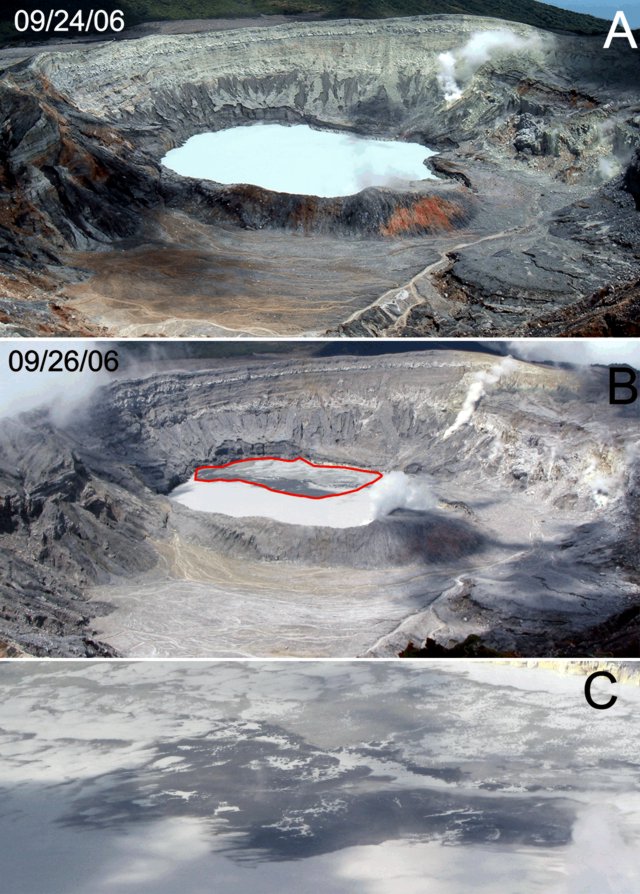Report on Poas (Costa Rica) — August 2006
Bulletin of the Global Volcanism Network, vol. 31, no. 8 (August 2006)
Managing Editor: Richard Wunderman.
Poas (Costa Rica) Minor phreatic eruptions on 25-26 September 2006
Please cite this report as:
Global Volcanism Program, 2006. Report on Poas (Costa Rica) (Wunderman, R., ed.). Bulletin of the Global Volcanism Network, 31:8. Smithsonian Institution. https://doi.org/10.5479/si.GVP.BGVN200608-345040
Poas
Costa Rica
10.2°N, 84.233°W; summit elev. 2697 m
All times are local (unless otherwise noted)
At least two phreatic eruptions took place at the crater lake in the main crater at Poás volcano on 25-26 September 2006. Prior to the eruption, the warm hyper-acid crater lake (figure 81 (A)) was a weak turquoise color. It later turned milky gray.
The first eruption, during the night of 25 September, sent material to a height of at least 350 m above the crater lake. It deposited hydrothermally altered rock fragments, mud, and water in the S sector of the inner crater and outside the W part of the crater. Mud was found deposited ~ 500 m from the main crater. Sulfur chunks up to 35 cm in diameter and rock, including old pieces of andesite, failed to travel father than the confines of the crater. Ash erupted the night of 25 September reached ~ 10 km SW (to Trojas de Sarchí).
Observers noted another, smaller, minor eruption at 1038 on 26 September. That eruption had effects limited to the area of the crater lake (figure 81 (B)), where it formed spots of black and green-yellow mud and sulfur spread across a zone up to 75 m long. The process was interpreted to correspond with material coming from subaquatic pools of molten sulfur rising to the lake surface (figure 81 (C)).
A visit into the crater on the 27th determined the lake temperature and pH, 45°C and 0, respectively. The visitors also measured the temperatures of fumaroles ( > 95°C) and an orange fumarole, over 200°C. Samples of lake water and erupted mud were obtained.
Geological Summary. The broad vegetated edifice of Poás, one of the most active volcanoes of Costa Rica, contains three craters along a N-S line. The frequently visited multi-hued summit crater lakes of the basaltic-to-dacitic volcano are easily accessible by vehicle from the nearby capital city of San José. A N-S-trending fissure cutting the complex stratovolcano extends to the lower N flank, where it has produced the Congo stratovolcano and several lake-filled maars. The southernmost of the two summit crater lakes, Botos, last erupted about 7,500 years ago. The more prominent geothermally heated northern lake, Laguna Caliente, is one of the world's most acidic natural lakes, with a pH of near zero. It has been the site of frequent phreatic and phreatomagmatic eruptions since an eruption was reported in 1828. Eruptions often include geyser-like ejections of crater-lake water.
Information Contacts: Raul Mora and Carlos Ramírez, Red Sismologica Nacional (RSN: UCR-ICE); Universidad de Costa Rica, Escuela Centroamericana de Geología, Instituto Costarricense de Electricidad, Apto 35-2060, Ciudad Universitaria Rodrigo Facio, San José, Costa Rica (URL: http://rsn.ucr.ac.cr/).


